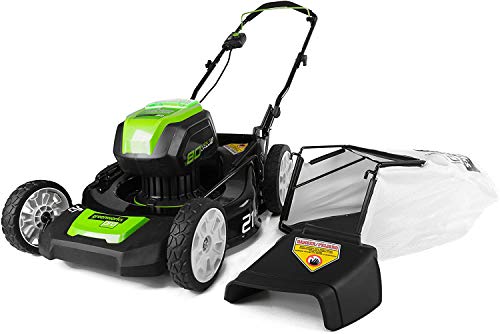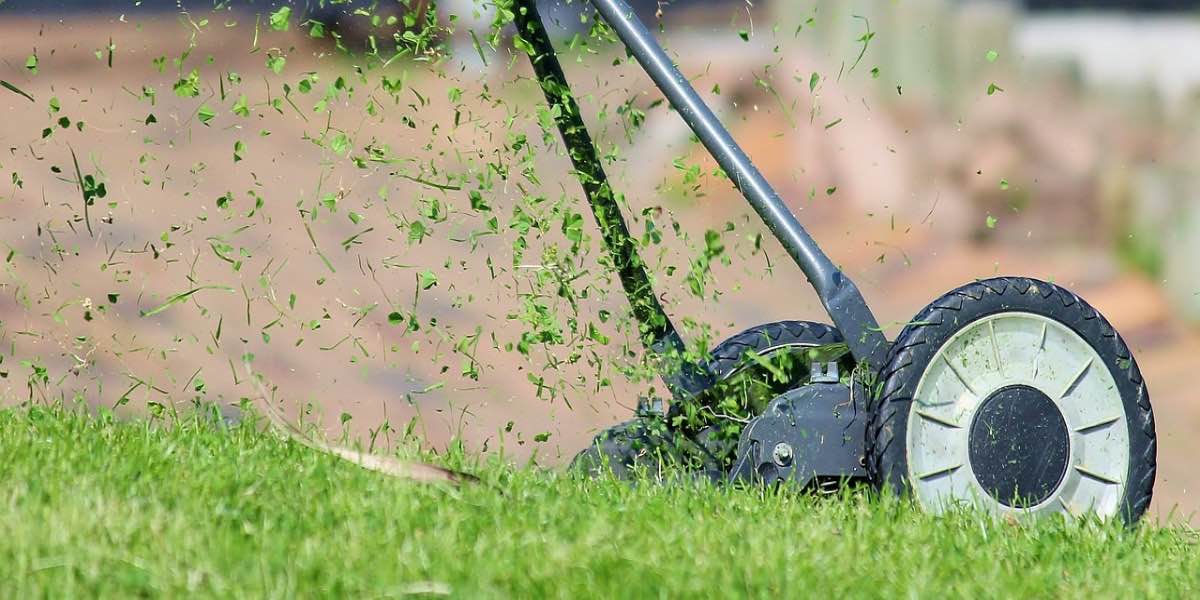

We earn affiliate commissions at no extra cost to you.
If your grass is not getting clean cuts anymore, it may be time to sharpen the blade. Typical signs are if your grass is being torn and tattered rather than cleanly sliced, or you see your lawn isn't evenly cut even after mowing. A dull blade doesn't cut - it tears.
But how do you sharpen your lawn mower blade? Well it depends on your type of mower.
When people say "push mower", it can mean either a manual reel mower (the old school ones that use no electricity) or a walk-behind rotary mower (the "typical" lawn mower).
In this article, when we say "sharpen a push mower blade", we're talking about how to sharpen a manual reel mower.
A reel mower basically works like a pair of scissors - two blades slide against each other to cause the cutting to happen. In a reel mower, you have of course the cylindrical blades (the reel), but you also have a base blade (called the bed knife) at the bottom of the mower that the reel blades brush up against.
We need to sharpen both the reel blades and the bed knife.
There are two ways to get this done: you can either use a handheld sharpening tool and drag it across each blade to sharpen it, or you can apply a grinding paste onto each blade and rotate the reel blades for 10 minutes against the bed knife, letting friction do its work.
The first option, using a handheld sharpening tool for reel mowers, is the faster and easier method to do. But the downsides are that it costs more to buy the tool, and also you run the risk of not evenly sharpening the blades if you don't use it properly (which can ruin your mower).
The second option, using a grinding compound, is cheaper to buy and you'll get a nice even sharpen, but requires you to disassemble the reel mower partially. It also takes 8-10 minutes to sharpen the blades which can be a bit tiring.
My suggestion is that if just want to save time and are afraid of disassembling your mower, just buy the handheld sharpening tool and you'll be fine.
Or if you don't mind the extra maintenance time needed and want to save money, do the second method with grinding paste. It can also be more fun for those of you who are DIY enthusiasts.
Let's walk through how to do both methods here.
A handheld sharpener made specifically for sharpening push mower blades makes the job pretty straightforward - it's just 3 simple steps.
Here is a nice video guide on using a handheld sharpener to sharpen push mower blades.

We'll be using timestamps of this video throughout our guide, so you can click on those timestamps if you need a visual reference of that step.
Wear your gloves and secure the reel blades with one hand by grabbing a hold of the middle bar ( Video example ). With your other hand, hold the handheld sharpener and glide it across one of the reel blades.
Try to do this evenly, you don't want to over sharpen one blade and make it uneven with the other blades.
The bed blade is the base blade that the reel brushes up against to cut the grass. Using the sharpening tool, rub it evenly against the bed blade. Note that you are using a different part of the sharpening tool to sharpen the bed blade than the reel blades. ( Video example )
At this point, the blades have become a bit shorter since you just sharpened it. You'll now need to adjust the connecting point where the reel meets the bed blade to be closer, otherwise the gap will be too big to make a clean cut.
There are usually two bolts on each side of the bed blade. Tightening the bolt further away from the reel and loosening the bolt closer to it will close the gap. And doing the opposite will cause the gap to widen. ( Video example )
Get a piece of paper and put it in between the bed blade and the reel, and try cutting the paper by rotating the reel blades slowly. If it cuts, you have adjusted it correctly. Keep using this as reference while tightening and loosening the bolts until you get a nice cut.
Make sure you also adjust the 2 bolts on the other side of the mower as well so that the cut is even. That's it, you're done!
This method is a bit more complicated than the previous one, but you can do it quite cheaply and get a nice and even sharpen. The idea is to apply some grinding paste to the reel blades, disassemble one of the wheels, then use a power drill to run the reel against the bed blade for 8-10 minutes until it is sharpened.
Here is a good video guide on how to do this:

I'll be putting timestamps throughout this guide of that video for you to easily see specific steps for visual reference.
First we need to adjust the cylindrical blades (the reel) to be closer to the bottom blade it slides against (the bed blade). There are 4 screws - 2 on each side of the bed blade.
Loosen the screws closer to the reel and tighten the screws further away from the reel to make the gap between the bed blade and the reel closer. ( Video example )
We want it to be tighter because we'll be using this friction to cause the sharpening to happen. The result is that you can still rotate the reel, but you'll feel a bit of resistance.
Now that the blades are closer, it's time to apply the grinding paste. Take out your acid brush and squeeze some grinding compound onto it, then brush over each blade on the cylindrical reel. Nice and smooth - make sure to apply it evenly. ( Video example )
Take your screwdriver and flick open the cap covering the center of the wheel. Inside you will see a metal clip shaped like a "C", which you will also want to flick off using the screwdriver. ( Video example )
Once you've done that, you will be able to remove the entire wheel. Inside you will see a gear, which you can remove by hand to expose the drive bar.
Using your power drill, clamp it over the exposed drive bar and turn it on to forcefully spin the reel in reverse against the bed blade. ( Video example )
The friction and the grinding paste should be doing its job of sharpening the blades. After 8-10 minutes, the flat of the blades should have a more metal sheen to it.
Put back on the gear, then the wheel, then don't forget to stick back in the metal "C" clip, and finally put the cover cap back on.
With the mower put back together, test the sharpness with a piece of paper slipped in where the grass is usually cut, and turn the reel slowly. If it cuts the paper cleanly, that means you did a good job sharpening it.
You should sharpen your push mower blades whenever you notice your grass is not being cut cleanly anymore. Sometimes that is once per season, sometimes it is once every 3 years. It really depends on your usage.
There is usually a hole near the wheels of your reel mower where you can pour some oil or grease into. Bike lube (for bike chains) works really well. Just pour a bit in and move the wheel to keep it lubricated.
If sharpening the blades is still not getting you a proper cut, it's possible the blades have been warped or have nicks in them that make the blades uneven. In that case, it may be better to just buy a new reel mower or replace the blades.

98 Superb! ( 450 reviews )

EGO Power+ LM2102SP
99 Superb! ( 5101 reviews )

Greenworks 80V 21"
97 Superb! ( 1558 reviews )

EGO Power+ LM2101
98 Superb! ( 1091 reviews )

How to Remove Weeds Permanently in Your Garden

Lawn Mower Tips: How to Check and Test an Alternator With A Multimeter

What is a Weed Eater? Tips to Use a Weed Whacker Like a Pro

Mulch Calculator: How Much Mulch Do I Need for My Garden?

Laying Mulch: How to Succesfully Mulch Your Garden and Other Tips

Tips on How to Use a Leaf Blower to Clean Your Lawn

How to Mow a Lawn and Other Useful Lawn Mowing Tips

Signs of Blown Lawn Mower Head Gasket and Useful Repair Tips

Your Essential Guide on How to Successfully Dethatch a Lawn